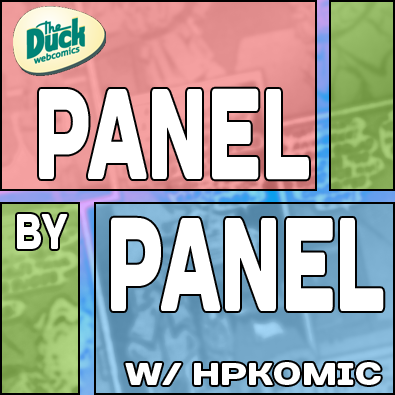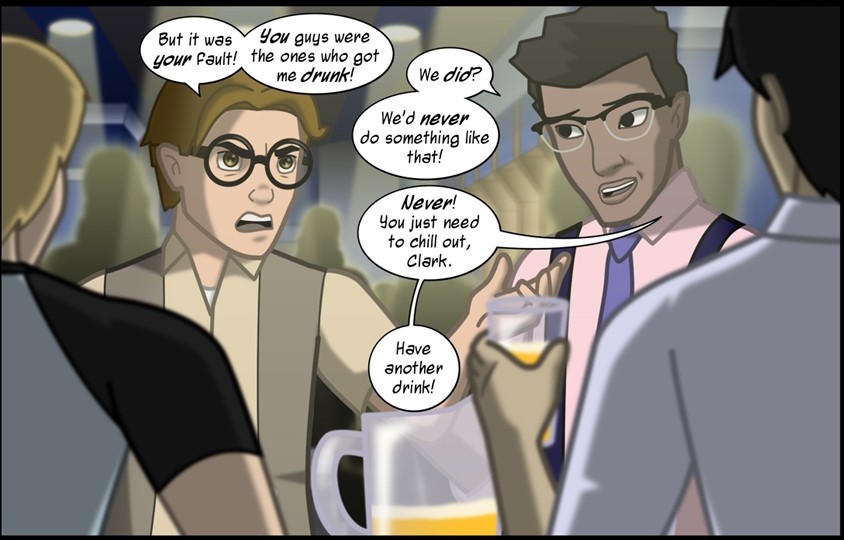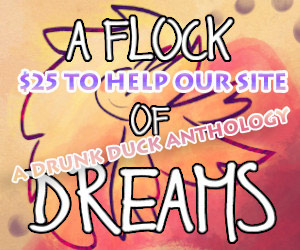
Hello, everyone, and welcome to Panel by Panel, a periodic exploration of comic panels around The Duck. One fun thing about doing comics digitally is that it opens up all sorts of helpful tools you may not have in traditional artwork. For example, blurring things to imply a depth of field. Today, we're going to look at a panel from the comic Dude In Distress by EssayBee. Specifically, we'll be looking at a panel on the third strip of the comic.
So, one thing I want to mention before I talk about depth of field here is that the artwork has a feeling of being a still from a cartoon. The lines are clean and crisp. This looks like something I'd have seen as high-quality web animation back during the days of Macromedia Flash. As for the panel, here. I want to emphasize the usage of blurring to simulate depth.
We have three fields here. The foreground comprises the closest objects. The mid-ground serves as our focal point. The background provides a sense of space. The foreground and background are blurred to create depth while we naturally focus on the sharp detail of the mid-ground, which is where most of our speaking characters are. This is a standard visual if we were watching something on film. It is an essential technique in photography, for example. It is less so in comics because it can be disorienting or labor-intensive. However, it can have its place, such as this panel, which is why it works here.
Part of the ease here comes from being what appears to be digitally produced artwork. I am unsure what EssayBee's workflow is like, but I suspect layers constitute a significant part of this panel's construction. I see at least three of them here, one for each field. You can create a blur pretty easily in Adobe Photoshop, for example.
The trick is knowing when to use it. Blurring in every panel would be much, mainly because it tends to wash out art. Here, we see it used extensively on this page because of the nature of the shot-reverse-shot flow of the conversation. Think of using depth of field as a spotlight. It is there for emphasis. If the spotlight is always on, then what are you emphasizing? So, creating the illusion of depth of field with selective blurring is a tool to have in your kit, but the thing about tools is that they're not suited for every situation.
But, how about you and your comics? Do you use blurring in any of your panels or pages? Why not share them in the comments? I'd love to see them! Otherwise, give Dude In Distress a read and support another comic here on The Duck.
If you want to find earlier editions of Panel By Panel, click here.
____________
Don’t forget you can now advertise on DrunkDuck for just $2 in whichever ad spot you like! The money goes straight into running the site. Want to know more? Click this link here! Or, if you want to help us keep the lights on you can sponsor us on Patreon. Every bit helps us!
Special thanks to our patrons!!



Justnopoint - Banes - RMccool - Abt_Nihil - Gunwallace - PaulEberhardt - Emma_Clare - FunctionCreep - SinJinsoku - Smkinoshita - jerrie - Chickfighter - Andreas_Helixfinger - Tantz_Aerine - Genejoke - Davey Do - Gullas - Roma - NanoCritters - Teh Andeh - Peipei - Digital_Genesis - Hushicho - Palouka - cheeko - Paneltastic - L.C.Stein - dpat57 - Bravo1102 - The Jagged - LoliGen - OrcGirl - Miss Judged - Fallopiancrusader - arborcides - ChipperChartreuse - Mogtrost - InkyMoondrop - Jgib99 - Hirokari - Orgivemedeath Ind - Mks Monsters - GregJ - Soushiyo

Panel By Panel: 'Dude in Distress' and Depth of Field
hpkomic at 2:57PM, Sept. 22, 2023
3 likes!


©2011 WOWIO, Inc. All Rights Reserved Mastodon





KAM at 1:36PM, Sept. 23, 2023
One trick I've been doing is paint the backgrounds rather than draw ink lines to be filled in.
Banes at 7:16AM, Sept. 23, 2023
It's so effective to blur an object in the foreground. It's something I've used and it raises the bar on my...elementary visuals. A trick I don't overuse. Just once in awhile. But it looks awesome.
PaulEberhardt at 12:30AM, Sept. 23, 2023
I sometimes use blurring, but usually for backgrounds. Blurring the closest object is a bit tricky to do in traditional line-heavy art - it's possible, though.
marcorossi at 10:59PM, Sept. 22, 2023
I use this "blur the closest object" sometimes. I do this when the focal point of attention is not the closest element to the camera: intuitively the closest element tends to be the focus of attention, but by blurring it the attention is shifted to the next closer "level" of the image.
J_Scarbrough at 6:13PM, Sept. 22, 2023
I've been noticing more and more of this sort of depth in digital artwork in recent year, and not just exclusively in comics, but also in fan art and original artwork as well, and I will admit it's not something the eye is used to seeing in something that's not live-action or real-life, but it is quite an interesting take on a scene that may or may not work to the advantage of creating the depth the scene wants to convey.
bravo1102 at 4:12PM, Sept. 22, 2023
Two names Lee Garmes and Greg Toland. Study cinematography in movies before 1950 and you will learn everything there is to know about depth of field.